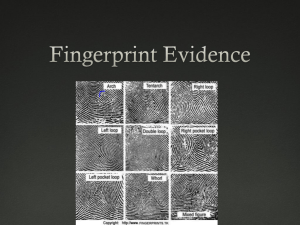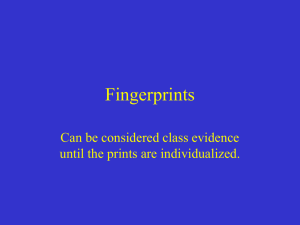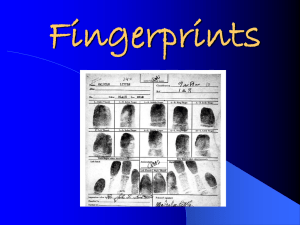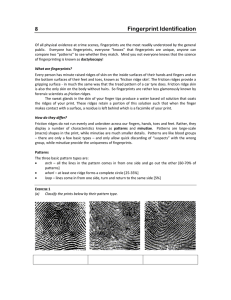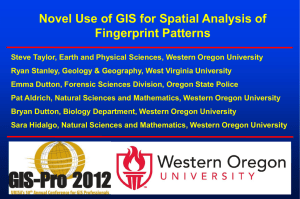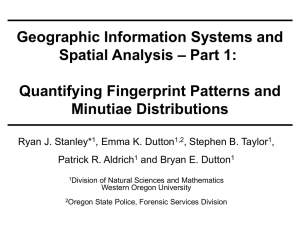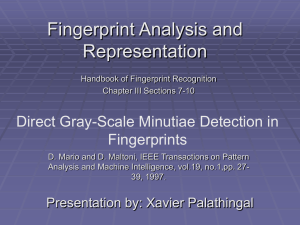FINGERPRINTS
advertisement
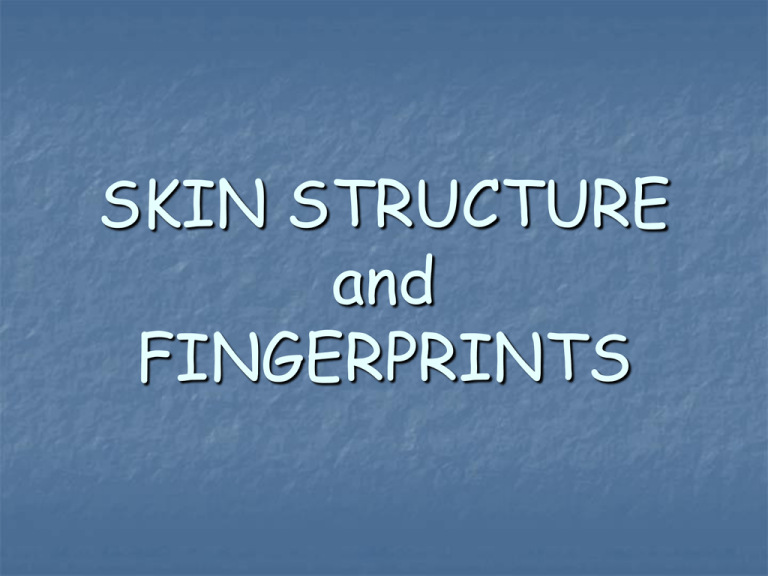
SKIN STRUCTURE and FINGERPRINTS SKIN STRUCTURE SKIN STRUCTURE The uppermost layer of the skin structure is the epidermis, which itself contains several layers: the basal cell layer, which is the deepest layer of the epidermis. Here cells divide to produce new skin cells, which move towards the skin surface, pushed upward by the dividing cells below them. the spinous cell layer, the granular cell layer, and the stratum corneum which is the top layer of the epidermis that we see from the outside. These cells are dead, contain a lot of keratin and are arranged in overlapping layers that make them tough and waterproof. SKIN STRUCTURE The dermis contains a variable amount of fat, collagen and elastin fibres which provide strength and flexibility to the skin. Blood vessels supply nutrients and remove any waste products. They also help maintain body temperature by dilating and narrowing. Nerves in the dermis detect heat, cold, pain, pressure and touch and relay this information to the brain. SKIN STRUCTURE A sebaceous gland opens into each hair follicle and produces sebum, a lubricant for the hair and skin that helps repel water, damaging chemicals and microorganisms. Sweat glands occur on all skin areas — each person has more than 2 million. Sweat moves to the skin’s surface via the sweat duct, and evaporation of this water from the skin has a cooling effect on the body. SKIN STRUCTURE The papillary layer is the dermal layer responsible for fingerprints. FINGERPRINTS What Are they? They are the marks left behind when someone touches an object. Fingerprints can be: an impression left in something soft, such as putty, wet paint a print left by a hand covered in blood, dirt, paint, etc an invisible deposit left by the secretions from the skin (oils and perspiration from tiny pores. These types of prints are called latent prints. FINGERPRINT PATTERNS The three main patterns of fingerprints are the - ARCH - LOOP - WHORL To help identify a fingerprint as one of these patterns, you look for delta points. These are triangular shapes that form where two patterns meet. Arch Patterns Arches are patterns that run from one side of the finger to the other with out making any backwards turns, so an arch actually has no delta. A plain arch: appears like waves tending to flow through the print A tented arch: Has an upward ridge that gives the pattern a spine Loop Patterns Loops are the most common print. Where a ridge makes a backwards turn a loop is formed. Radial and Ulnar Loops: Double Loop: These loops slope downwards toward the thumb (radial) or little finger (ulnar) Has two clear intertwined loops, with two deltas and two cores Pocked Loop: This is like the loop, but with a small circle at the turning point Core Delta Whorl Patterns 25-35% of patterns encountered are whorls. In a whorl, ridges make a complete turn (a circuit). Any pattern that contains 2 or more deltas will be a whorl. - Plain whorl - - Tends to lead to a complete circuit Central Pocket whorl - Consists of one re-curving ridge, or an obstructions at right angles to the line of flow Composite or Mixed Patterns Composite patterns consist of a mixture of patterns, and may have three or more deltas. They are usually combinations of loops and whorls, and can also include tented arches. Some composite patterns are called ‘accidentals’ as the ridges are too irregular in outline to be grouped. Composite fingerprint patterns are not common. Fingerprint Identification Even with pattern classification, it would be impossible to declare two fingerprints to be from the same finger if you were relying purely on matching patterns….. The pattern is important, but it is the actual characteristics of the print, ie. the little variations that occur in the ridge patterns, that enable prints to be matched. Fingerprint Identification (cont’d): The procedure involves: Fingerprint pattern is determined Detection of minutiae (specific and identifiable ridge patterns) Comparison of the relative positions of the minutiae points with a reference print (usually an inked impression of the suspect’s print) Ridge Characteristics There are three basic ridge characteristics: - The ridge ending - The bifurcation - The dot and the island dot island Ridge characteristics are called minutiae Basic and composite ridge characteristics (minutiae) Minutiae Example Minutiae ridge ending bridge bifurcation double bifurcation dot trifurcation island (short ridge) opposed bifurcations lake (enclosure) ridge crossing hook (spur) opposed bifurcation/ridge ending Example Try to identify am many minutiae as you can on these fingerprints



